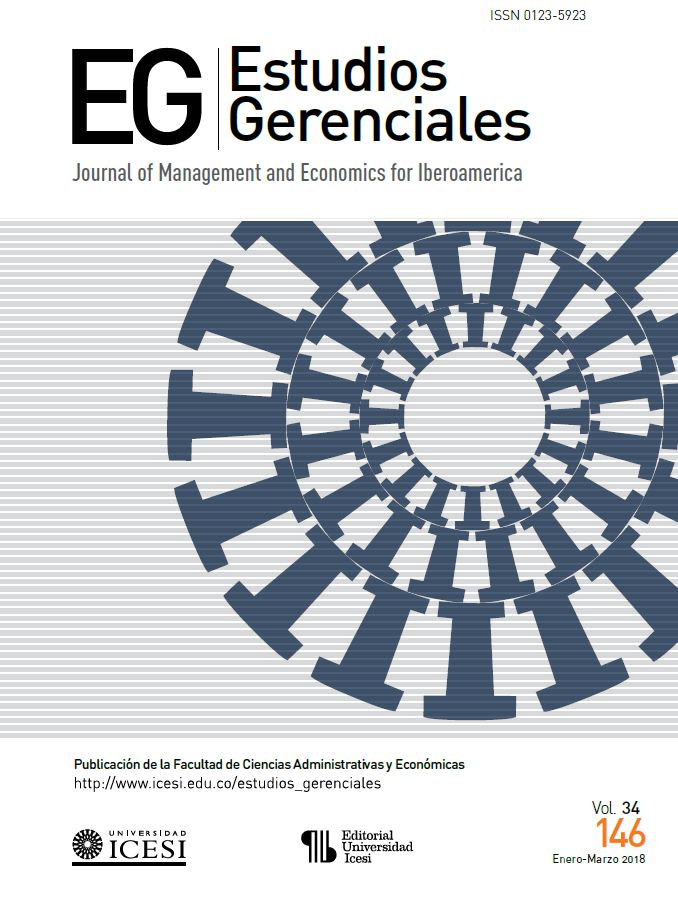Distrinox, como crescer lucrativamente?
DOI:
https://doi.org/10.18046/j.estger.2018.146.2805Palavras-chave:
Orientação ao mercado, Gestão de clientes, Crescimento, RentabilidadeResumo
O objetivo deste estudo de caso é colocar em prática a gestão de clientes em uma empresa colombiana que importa e vende aço inoxidável para garantir seu crescimento lucrativo. Para isso, foram compiladas informações sobre o mercado, os concorrentes, a empresa, seus produtos e seus clientes para que o leitor possa recomendar ações sobre a oferta de produtos e serviços e assim crescer de forma rentável.
Downloads
Referências
Anderson, J. C., Narus, J. A. y Narayandas, D. (2009). Business Market Management: Understanding, Creating, and Delivering Value (3ra ed.). Upper Saddle River: Pearson Prentice Hall.
Barney, J. B. (2001). Resource-based theories of competitive advantage: A ten-year retrospective on the resource-based view. Journal of Management, 27(6), 643-650.
Barney, J. B. (2014). How marketing scholars might help address issues in resource-based theory. Journal of the Academy of Marketing Science, 42(1), 24-26.
Blattberg, R. C. y Deighton, J. (1996). Manage marketing by the customer equity test. Harvard Business Review, 74(4), 136-144.
Castellanos Ordoñez, G. y Solano Arboleda, D. (2017). Metaanálisis de la relación entre la orientación al mercado y los resultados de la empresa. Estudios Gerenciales, 33(142), 87-94. http://doi.org/10.1016/j.estger.2016.10.006
Day, G. S. (2003). Creating a superior customer-relating capability. MIT Sloan Management Review, 44(3), 77-82.
Deshpande, R., Farley, J. y Webster, F. (1993). Corporate culture, customer orientation, and innovativeness. Journal of Marketing, 57(1), 23-27. http://doi.org/10.2307/1252055
El Tiempo. (2016). Panorama económico de Colombia en 2017. Recuperado el 24 de octubre de 2017 de: http://www.eltiempo.com/economia/sectores/panorama-economico-de-colombia-en-2017-38145
Heskett, J. L. y Schlesinger, L. A. (1994). Putting the service-profit chain to work. Harvard Business Review, 72(2), 164-174.
Hunt, S. D. y Lambe, C. J. (2000). Marketing’s contribution to business strategy: market orientation, relationship marketing and resource‐advantage theory. International Journal of Management Reviews, 2(1), 17-43.
Kohli, A. K. y Jaworski, B. J. (1990). Market orientation: the construct, research propositions, and managerial implications. The Journal of Marketing, 54(2), 1-18.
Kotler, P. y Amstrong, G. (2013). Fundamentos de Marketing (11 ed.). Naucalpan de Juárez: México: Pearson Educacion.
Legiscomex. (2017). Base de datos. Recuperado el 24 de octubre de 2017 de: https://www.legiscomex.com
Narayandas, D. (2002). Note on Customer Management. Harvard Business School Publishing, N° 502073.
Narver, J. C. y Slater, S. F. (1990). The effect of a market orientation on business profitability. The Journal of Marketing, 54(4), 20-35.
Peppers, D., Rogers, M. y Dorf, B. (1999). Is your company ready for one-to-one marketing. Harvard Business Review, 77(1), 151-160.
Porter, M. E. (1998). The Competitive Advantage: Creating and sustaining superior performance. New York: Free Press.
Rodriguez-Cano, C., Carrillat, F. A. y Jaramillo, F. (2004). A meta-analysis of the relationship between market orientation and business performance: evidence from five continents. International Journal of Research in Marketing, 21(2), 179-200.
Downloads
Publicado
Edição
Seção
Licença
Os autores dos artigos serão responsáveis dos mesmos e, assim, não comprometam os princípios ou políticas da Universidade Icesi nem do Conselho Editorial da revista Estudios Gerenciales. Os autores autorizam e aceitam a transferência de todos os direitos para a revista Estudios Gerenciales para a publicão impressa ou eletrônica. Após a publicação do artigo, pode ser reproduzido sem a permissão do autor ou da revista, se mencionar o(s) autor(es), o ano, o título, o volume e o número e o intervalo de páginas da publicação, e Estudios Gerenciales como fonte (se abster de utilizar Revista Estudios Gerenciales).








